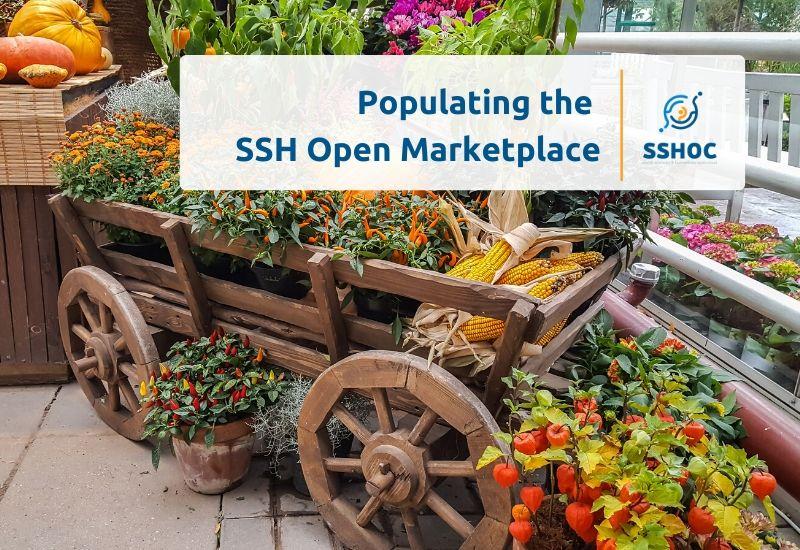
- Social Sciences & Humanities Open Cloud
SSH Open Marketplace: What's in it for You?

Date:
04 June 2020
On 30 June 2020 we will release the Alpha version of the SSH Open Marketplace. This second post in our dedicated series explains how the Marketplace content is being selected and organised, and describes the resources which will be available to researchers on launch.
Content defined
Content might typically be thought of as tools or web services, but our definition of content includes data sets, tutorials, training materials, articles, and in fact any element, regardless of form or type, that could contribute to or be a significant part of the research process in the Social Sciences and Humanities and is digitally available. We are aware that this definition of what we call "contextualised content" is ambitious.
Given our focus on our prospective users, interactions with researchers and research support staff from the Social Sciences and Humanities were a key aspect of the Marketplace design phase. These interactions informed our decision to formulate our content population plan in with three main phases.
Initial onboarding phase
Up until the Alpha release we will be primarily ingesting well-known content collections. Some 1,500 individual resources have so far been selected and will constitute the minimum viable product. The most important sources are TAPoR, Programming Historian and the Standardization Survival Kit (SSK) from the PARTHENOS project.
TAPoR, led by Geoffrey Rockwell, is a well-recognised and fairly comprehensive registry of the digital humanities tools. In 2018, data from the DiRT directory were integrated and include a curated list of research tools for studying texts and a discovery interface.
From the Programming Historian, we are presenting content as tutorials accompanied by contextualised content. As explained previously, this includes supporting information such as software tutorials, related academic articles, and other useful resources. We adopt the same approach for the Standardization Survival Kit, a collection presented as research scenarios.
Extended population phase
Community feedback received during the Alpha release will inform our efforts to add further content to the Marketplace. We will also build on the experience of the initial onboarding phase to develop tools and strategies to handle as many sources as possible. Nevertheless, we expect many challenges particularly as regards “not- so- obvious sources” where only parts of the content are relevant to our users.
A key criterion for selection is the availability of high-quality source metadata and standardised vocabularies such as TaDiRAH. These allow for content tagging and seamless integration. The application of the FAIR data principles at the source is therefore a helpful pre-condition for us.
Equally, well-documented data models and machine-readable APIs that also offer readability of the scheme in use at hand will enable regular and automatic content updates. Without these, a very detailed analysis process will need to be initiated, and the content mapped to the data model manually. As the aim is not only to have much content present but also to connect the elements to provide context, population from new sources will need to include associated background information on digital research methods and approaches. For this we will rely heavily on the support of the Social Sciences and Humanities research communities.
Community supported phase
Once the Marketplace has reached a certain maturity and uptake by the users, we intend to include the community substantially in the curation and enhancement of the content. Community curation might be as simple as a suggested correction or a comment to a specific item, but could take more advanced shapes.
One pillar of a successful platform is the availability of powerful curation workflows and tools that help to improve the quality of the data, thus enriching the content and helping users gain new perspectives. In this regard, the development of curation tools will be a major focus of this phase.
Offering a wide selection of useful material is key to attracting an open and active community. We believe our curated, context-driven approach will help researchers gain new ideas, useful documents, exciting tools to try out, and recommendations by peers from different research communities, institutions and countries. We envision a lively community boosting the SSH Open Marketplace not only for the benefit of the SSH domain but also as an integral part of the larger European Open Science Cloud where it will dovetail with many other disciplines.
Your Contribution
When and how can you be involved in the creation of the SSH Open Marketplace?
- Right now join the SSHOC Community and register as a tester click here.
- From December 2020: As a contributor you'ill be able to suggest new content or ways to enrich existing items
- Between December 2020 and December 2021: As a member of the still-to-be-created:editorial team
All users involved in the SSH Open Marketplace as testers, contributors or members of the editorial team will be acknowledged and cited for their contribution and, when possible, other rewarding models will be considered.
To enquire about participation as a contributor or editor, please email us on info@sshopencloud.eu
For an early, sneak peek at the SSH Marketplace ahead of the 30 June official launch, join the #SSHOCifyDARIAH Twitter Takeover on 17 June!
